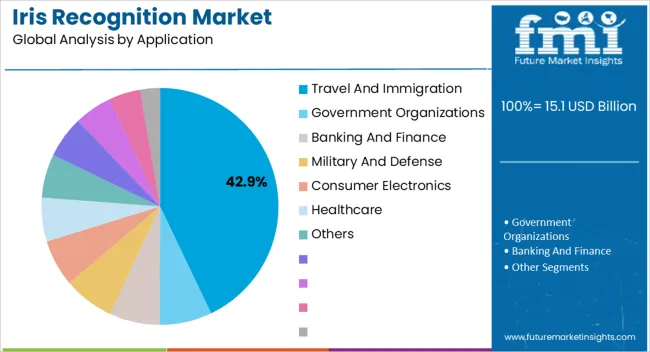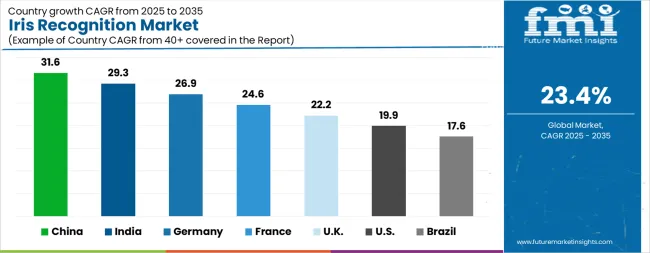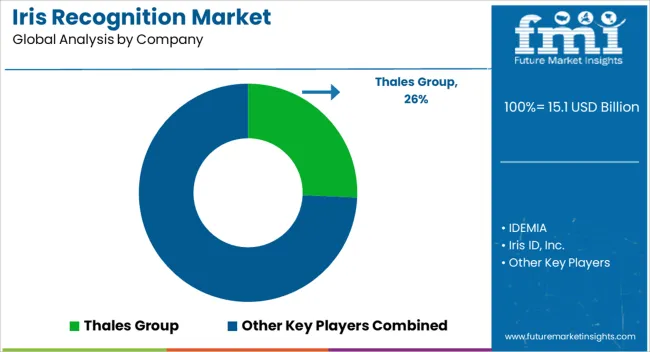The Iris Recognition Market is estimated to be valued at USD 15.1 billion in 2025 and is projected to reach USD 123.6 billion by 2035, registering a compound annual growth rate (CAGR) of 23.4% over the forecast period.

| Metric | Value |
|---|---|
| Iris Recognition Market Estimated Value in (2025 E) | USD 15.1 billion |
| Iris Recognition Market Forecast Value in (2035 F) | USD 123.6 billion |
| Forecast CAGR (2025 to 2035) | 23.4% |
The Iris Recognition market is experiencing substantial growth, driven by the increasing need for highly secure, accurate, and contactless biometric authentication systems across various sectors. The current market scenario is shaped by the widespread adoption of biometric identification in smartphones, travel, immigration, and enterprise security solutions. Iris recognition technology offers superior precision, reduced fraud risk, and faster authentication compared with other biometric methods, supporting its integration into mobile devices and identity management systems.
The future outlook of the market is being influenced by advancements in imaging sensors, AI-based pattern recognition, and edge computing, which enhance performance under diverse lighting conditions and environmental scenarios. Growing concerns over data security and the demand for efficient, touchless authentication solutions are reinforcing investment in this technology.
As organizations and governments seek scalable biometric solutions for secure access, identity verification, and border management, the Iris Recognition market is expected to continue expanding Emerging opportunities are anticipated in travel facilitation, digital identity initiatives, and integration into multi-factor authentication ecosystems, which collectively drive sustained market adoption.
The iris recognition market is segmented by component, product, application, and geographic regions. By component, iris recognition market is divided into Hardware, Software, and Service. In terms of product, iris recognition market is classified into Smartphones, Computers, Scanners, Wearables, and Others. Based on application, iris recognition market is segmented into Travel And Immigration, Government Organizations, Banking And Finance, Military And Defense, Consumer Electronics, Healthcare, and Others. Regionally, the iris recognition industry is classified into North America, Latin America, Western Europe, Eastern Europe, Balkan & Baltic Countries, Russia & Belarus, Central Asia, East Asia, South Asia & Pacific, and the Middle East & Africa.

The hardware component is projected to hold 51.80% of the Iris Recognition market revenue in 2025, making it the leading component segment. This leadership is being driven by the critical role of imaging sensors, near-infrared cameras, and optical modules in capturing precise iris patterns. Hardware investments are prioritized because accuracy, speed, and reliability in biometric recognition largely depend on the physical components.
Increased deployment in mobile devices, border control systems, and secure access infrastructure has reinforced the demand for high-quality hardware modules. The growth of this segment is also supported by the need for durable and compact sensors capable of operating under various environmental conditions.
Hardware improvements allow seamless integration with software algorithms, enabling real-time processing and high matching accuracy The segment benefits from continuous innovation in miniaturized optics, sensor performance, and energy efficiency, which facilitates adoption in both enterprise and consumer applications, driving its leading revenue share.

Smartphones are expected to account for 47.30% of the Iris Recognition market revenue in 2025, emerging as the leading product segment. The dominance of smartphones is being attributed to the growing trend of embedding biometric authentication into personal devices for secure mobile payments, application access, and device unlocking. Iris recognition provides enhanced security and faster authentication compared with traditional PINs or fingerprint recognition, which has accelerated adoption in premium and mid-tier mobile devices.
The convenience of contactless verification and compatibility with AI-based software for anti-spoofing and liveness detection further supports the segment’s growth. Expanding smartphone penetration in both developed and emerging markets has amplified the demand for integrated iris sensors.
Additionally, the miniaturization of high-performance optical modules allows seamless integration without affecting device form factor As users increasingly prioritize security, privacy, and frictionless authentication, smartphones are anticipated to continue dominating the product segment in the Iris Recognition market.

The travel and immigration application segment is projected to hold 42.90% of the Iris Recognition market revenue in 2025, making it the leading application segment. The segment’s growth is being driven by the need for fast, accurate, and reliable passenger identification at airports, border crossings, and immigration checkpoints. Iris recognition provides superior accuracy and security, reducing fraud, identity theft, and processing times for travelers.
Adoption is being reinforced by governments implementing automated border control and e-gate systems to streamline immigration processes. The non-contact nature of iris scanning ensures hygiene and convenience, which is particularly important in high-traffic environments. Furthermore, integration with centralized identity databases and AI-driven analytics enables scalable deployment for large populations.
Increasing global travel, the expansion of smart airport initiatives, and stringent regulatory requirements for secure identity verification are contributing to sustained growth in this segment The capability to rapidly authenticate identities while maintaining high accuracy ensures that travel and immigration remain a dominant application for iris recognition technology.
Iris recognition is a technology which is accurate and efficient for security of data, individual and other such valuable assets. Iris recognition is gaining traction these days due to its use in consumer electronics products like computers and laptops. Embedding of iris recognition technology to laptops has led to widespread awareness about the feature and reliability it offers. Iris recognition is termed to be 10 times more secure but 10 times more expensive technology then the fingerprint scanner technology. Iris recognition market has started its transition to cut down its cost and is seen as a potential technology for identity management in the near future.

| Country | CAGR |
|---|---|
| China | 31.6% |
| India | 29.3% |
| Germany | 26.9% |
| France | 24.6% |
| UK | 22.2% |
| USA | 19.9% |
| Brazil | 17.6% |
The Iris Recognition Market is expected to register a CAGR of 23.4% during the forecast period, exhibiting varied country level momentum. China leads with the highest CAGR of 31.6%, followed by India at 29.3%. Developed markets such as Germany, France, and the UK continue to expand steadily, while the USA is likely to grow at consistent rates. Brazil posts the lowest CAGR at 17.6%, yet still underscores a broadly positive trajectory for the global Iris Recognition Market. In 2024, Germany held a dominant revenue in the Western Europe market and is expected to grow with a CAGR of 26.9%. The USA Iris Recognition Market is estimated to be valued at USD 5.2 billion in 2025 and is anticipated to reach a valuation of USD 32.1 billion by 2035. Sales are projected to rise at a CAGR of 19.9% over the forecast period between 2025 and 2035. While Japan and South Korea markets are estimated to be valued at USD 828.2 million and USD 402.3 million respectively in 2025.

| Item | Value |
|---|---|
| Quantitative Units | USD 15.1 Billion |
| Component | Hardware, Software, and Service |
| Product | Smartphones, Computers, Scanners, Wearables, and Others |
| Application | Travel And Immigration, Government Organizations, Banking And Finance, Military And Defense, Consumer Electronics, Healthcare, and Others |
| Regions Covered | North America, Europe, Asia-Pacific, Latin America, Middle East & Africa |
| Country Covered | United States, Canada, Germany, France, United Kingdom, China, Japan, India, Brazil, South Africa |
| Key Companies Profiled | Thales Group, IDEMIA, Iris ID, Inc., Iritech, Inc., Princeton Identity, NEC Corporation, SAP SE, HID Global Corporation, EyeLock LLC, and Hangzhou Hikvision Digital Technology Co., Ltd. |
The global iris recognition market is estimated to be valued at USD 15.1 billion in 2025.
The market size for the iris recognition market is projected to reach USD 123.6 billion by 2035.
The iris recognition market is expected to grow at a 23.4% CAGR between 2025 and 2035.
The key product types in iris recognition market are hardware, software and service.
In terms of product, smartphones segment to command 47.3% share in the iris recognition market in 2025.






Our Research Products

The "Full Research Suite" delivers actionable market intel, deep dives on markets or technologies, so clients act faster, cut risk, and unlock growth.

The Leaderboard benchmarks and ranks top vendors, classifying them as Established Leaders, Leading Challengers, or Disruptors & Challengers.

Locates where complements amplify value and substitutes erode it, forecasting net impact by horizon

We deliver granular, decision-grade intel: market sizing, 5-year forecasts, pricing, adoption, usage, revenue, and operational KPIs—plus competitor tracking, regulation, and value chains—across 60 countries broadly.

Spot the shifts before they hit your P&L. We track inflection points, adoption curves, pricing moves, and ecosystem plays to show where demand is heading, why it is changing, and what to do next across high-growth markets and disruptive tech

Real-time reads of user behavior. We track shifting priorities, perceptions of today’s and next-gen services, and provider experience, then pace how fast tech moves from trial to adoption, blending buyer, consumer, and channel inputs with social signals (#WhySwitch, #UX).

Partner with our analyst team to build a custom report designed around your business priorities. From analysing market trends to assessing competitors or crafting bespoke datasets, we tailor insights to your needs.
Supplier Intelligence
Discovery & Profiling
Capacity & Footprint
Performance & Risk
Compliance & Governance
Commercial Readiness
Who Supplies Whom
Scorecards & Shortlists
Playbooks & Docs
Category Intelligence
Definition & Scope
Demand & Use Cases
Cost Drivers
Market Structure
Supply Chain Map
Trade & Policy
Operating Norms
Deliverables
Buyer Intelligence
Account Basics
Spend & Scope
Procurement Model
Vendor Requirements
Terms & Policies
Entry Strategy
Pain Points & Triggers
Outputs
Pricing Analysis
Benchmarks
Trends
Should-Cost
Indexation
Landed Cost
Commercial Terms
Deliverables
Brand Analysis
Positioning & Value Prop
Share & Presence
Customer Evidence
Go-to-Market
Digital & Reputation
Compliance & Trust
KPIs & Gaps
Outputs
Full Research Suite comprises of:
Market outlook & trends analysis
Interviews & case studies
Strategic recommendations
Vendor profiles & capabilities analysis
5-year forecasts
8 regions and 60+ country-level data splits
Market segment data splits
12 months of continuous data updates
DELIVERED AS:
PDF EXCEL ONLINE
Image Recognition in Retail Market Size and Share Forecast Outlook 2025 to 2035
Facial Recognition Market Size and Share Forecast Outlook 2025 to 2035
Facial Recognition Machine Market
Gesture Recognition Market
Employee Recognition Software Market Analysis - Size, Share, and Forecast 2025 to 2035
EHR Speech Recognition Solution Market Size and Share Forecast Outlook 2025 to 2035
Traffic Sign Recognition System Market Size and Share Forecast Outlook 2025 to 2035
Mobile Speech Recognition Software Market Size and Share Forecast Outlook 2025 to 2035
Social Employee Recognition System Market Size, Growth, and Forecast for 2025 to 2035
Social Employee Recognition System Market in Korea – Industry Outlook & Forecast 2025 to 2035
Optical Character Recognition Market Forecast and Outlook 2025 to 2035
Automatic Content Recognition Market Size and Share Forecast Outlook 2025 to 2035
Automotive Gesture Recognition Systems Market
Social Employee Recognition System Market in Japan - Growth & Forecast 2025 to 2035
Emotion Detection and Recognition Market
Automated Number Plate Recognition (ANPR) and Detection Sensors Market Size and Share Forecast Outlook 2025 to 2035
North America Employee Recognition Software Market – Growth & Outlook 2025 to 2035
Far Field Speech and Voice Recognition Market Size and Share Forecast Outlook 2025 to 2035
Western Europe Social Employee Recognition System Market - Trends & Forecast 2025 to 2035

Thank you!
You will receive an email from our Business Development Manager. Please be sure to check your SPAM/JUNK folder too.
Chat With
MaRIA